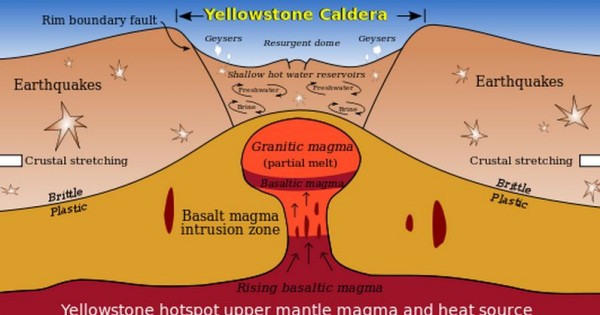Location and Probability of Yellowstone Super Eruption Predicted
| Arthur Dominic Villasanta | | Jan 04, 2015 09:53 AM EST |
Diagram of the Yellowstone caldera
The scientist considered the expert on earthquakes at Yellowstone National Park has come out with a prediction as to the chances of a super eruption at the Yellowstone caldera and where this massive catastrophe might take place.
Yellowstone, the largest volcanic field in North America, is the home to a caldera also called the "Yellowstone Supervolcano". It's located mostly in Wyoming but extends into Idaho and Montana.
Like Us on Facebook
University of Utah Professor Robert Smith, who has spent almost all his 40-year scientific career studying the Yellowstone caldera and the Teton Fault at the base of the Teton Range, believes "we'll have it (the next super eruption) in the northeast side of Yellowstone because that's where the shallowest magma is at Mirror Plateau."
Dr. Smith said movement of the Teton Fault could trigger the super eruption of the Yellowstone Supervolcano.
The Teton fault is located in northwestern Wyoming, has a length of 70 km and runs along the eastern base of the Teton Range. Scientists said large earthquakes of magnitude 6.5 to 7.0 could occur in Teton Range every 200 years.
One of nine Yellowstone plateaus, Mirror Plateau is west of the upper Lamar River and in the headwaters of Pelican Creek that flows into Yellowstone Lake.
Dr. Smith points out earthquakes are signs of magma movement in the Yellowstone volcano. He said earthquakes are the heartbeat of the active volcanic system in Yellowstone.
The magma movement is signaled by earthquakes. The strongest Yellowstone earthquake in 2014 occurred in March. The 4.8 magnitude quake was the biggest earthquake in 30 years, said Dr. Smith, who works at the university's Department of Geology and Geophysics.
Dr. Smith and a team from the University of Utah reported that the upward movement of the Yellowstone caldera floor between 2004 and 2008 was some three inches every year.
The team estimated the magma pool underneath Yellowstone's Supervolcano is 90 kilometers long. It was originally thought to be only 20 kilometers long.
"I contend that when the Yellowstone caldera goes up and down or when the magma influx occurs that the stresses of that magma chamber cause stresses on the Teton Fault to eventually rupture."
The rupture of the Teton Fault could trigger the long anticipated super eruption of the Yellowstone caldera.
"If we were to have another big eruption, it would affect a large area, on the order of several states. But, as I said, that probability is very, very, very, very small.
"In my calculations it's point zero, zero, zero, one percent," Dr. Smith said.
He also noted that previous giant eruptions of the Yellowstone Supervolcanoes probably lasted "many, many months, maybe even years."
Yellowstone's three monstrous volcanic eruptions occurred two million, 1.3 million and 600,000 years ago.
©2015 Chinatopix All rights reserved. Do not reproduce without permission
EDITOR'S PICKS
-

Did the Trump administration just announce plans for a trade war with ‘hostile’ China and Russia?
-

US Senate passes Taiwan travel bill slammed by China
-

As Yan Sihong’s family grieves, here are other Chinese students who went missing abroad. Some have never been found
-

Beijing blasts Western critics who ‘smear China’ with the term sharp power
-

China Envoy Seeks to Defuse Tensions With U.S. as a Trade War Brews
-

Singapore's Deputy PM Provides Bitcoin Vote of Confidence Amid China's Blanket Bans
-

China warns investors over risks in overseas virtual currency trading
-

Chinese government most trustworthy: survey
-

Kashima Antlers On Course For Back-To-Back Titles
MOST POPULAR
LATEST NEWS
Zhou Yongkang: China's Former Security Chief Sentenced to Life in Prison

China's former Chief of the Ministry of Public Security, Zhou Yongkang, has been given a life sentence after he was found guilty of abusing his office, bribery and deliberately ... Full Article
TRENDING STORY

China Pork Prices Expected to Stabilize As The Supplies Recover

Elephone P9000 Smartphone is now on Sale on Amazon India

There's a Big Chance Cliffhangers Won't Still Be Resolved When Grey's Anatomy Season 13 Returns

Supreme Court Ruled on Samsung vs Apple Dispute for Patent Infringement

Microsoft Surface Pro 5 Rumors and Release Date: What is the Latest?










